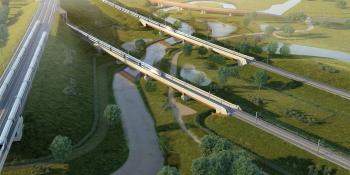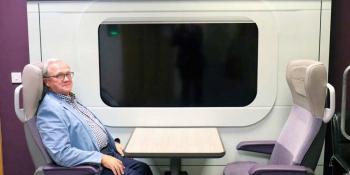EUROPE
CALLS FOR LIMITS ON LOW-COST OPERATIONS
The Brussels-based Alliance of Rail New Entrants (ALLRAIL) has raised concerns at EU level that incumbent state rail operators are using new ‘low-cost’ brands as a means of limiting competition both for domestic and cross-border services. ALLRAIL says in its statement issued in early October that the actions of incumbent operators, especially in France (SNCF) and Spain (RENFE), are stifling competition. ALLRAIL was founded in 2017 by ERFA, the association of non-incumbent rail freight companies, together with the biggest independent open access passenger operators in Europe – Leo Express,
MTR Nordic, NTV, Regiojet, Trainline and Westbahn. According to ALLRAIL, the fact that low-cost brands such as ‘Ouigo’ in France can access existing trains, track access paths in stations and maintenance facilities using ‘grandfather rights’ due to their state-owned parent companies restricts opportunities for others to operate at all. The lack of a leasing market for secondhand trains approved for use in France or Spain, despite older trains being available in both countries, also restricts market access and adds considerable cost and time for new entrants needing (as NTV did in Italy) to buy brand new high-speed trains.
ALLRAIL in particular takes aim at SNCF’s low-cost operations ‘Ouigo’ and ‘Izy’, saying they offer low fares while being subsidised by an operator with record levels of debt – and suggests they only exist to prevent other operators entering the market. ALLRAIL says ‘This amounts to state aid and is a major distortion of the market’. SNCF has led the trend with its ‘Ouigo’ low-cost brand, which it now intends to expand to 25% of all TGV services by 2020 (currently around 10%). SNCF’s majority-owned subsidiary Thalys introduced a low-cost brand, ‘Izy’, in 2016, operating only between Paris and Brussels. In Spain national operator RENFE has announced but not yet launched a low-cost brand called ‘Eva’, which will initially operate between Madrid and Barcelona from 2019 on the same route that Spain’s first open access high-speed operator plans to run trains on (see story below for more on these plans). ALLRAIL’s members have called on governments and the EU for widespread changes including:
■ incumbent national operators being compelled to lease underused trains to new independent entrants, in order to create a leasing market;
■ new entrants should be able to do this on the same lease terms and conditions as the internal subsidiaries;
■ make non-discriminatory access to heavy repair and maintenance facilities a reality in line with EU law;
■ a ban on scrapping old high-speed trains with these vehicles made available for lease to new operators.
The proposal concerning a prohibition of scrapping older high-speed trains would particularly apply in France, where single deck TGVs and Class 373 Eurostar trains have been scrapped in recent years (the latter in the UK) after being replaced by newer trains.
NEW CROSS-BORDER OPERATOR BLOCKED IN SPAIN
The plans by airline Air Nostrum’s subsidiary Intermodalidad de Levante SA (ILSA) to operate open access high-speed services between Madrid and Montpelier in France were approved by the Spanish national competition authority on 17 September. However, the plan to lease three S100 AVE 300km/h TGV-derived high-speed trains from state railway leasing company RENFE Alquiler has been blocked by RENFE, apparently with political backing from the government.
RENFE Alquiler initially informed ILSA the trains were not available or suitable for use in France – despite RENFE operating them into France daily! It has recently transpired that RENFE Alquiler sold all its passenger rolling stock back to RENFE in January, being paid around €119 million, with only freight locomotives and wagons now available for hire. The sale was disclosed in the RENFE Alquiler 2017 annual report (but not at the time) and covered the three S100 AVE trains ILSA wanted to lease, 12 S120 250km/h EMUs, two rakes of Talgo IV day coaches plus 12 Class 490 regional EMUs and five Class 598 regional DMUs.
ILSA has now appealed to the national competition authority to require RENFE to lease rolling stock in line with Spanish law reforming the railway sector and requiring RENFE to provide unused rolling stock to new entrants on commercial terms. Over 20 other potential new operators are reported by local media to have registered interest in operating passenger services, including DB Arriva and National Express subsidiary ALSA.
RENFE’s actions in apparently blocking access to private competitors in its home market are in direct contrast to its activities abroad; in Saudi Arabia RENFE is responsible for operation of the new Mecca – Medina high-speed route, which opened in September, and in the USA RENFE, along with Spanish national infrastructure manager ADIF, has been selected to operate and maintain the proposed Dallas to Houston high-speed line being built by private company Texas Central
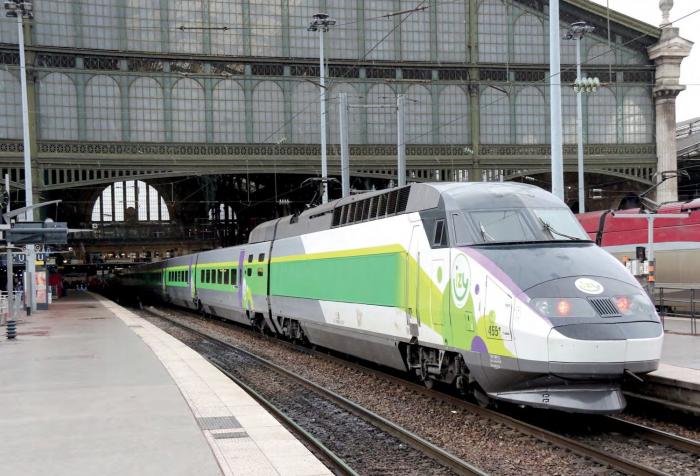
GERMANY
PESA LINK DMUs FOR DB FINALLY IN SERVICE
Polish manufacturer Pesa confirmed to Modern Railways at InnoTrans that it had delivered 16 of the 20 two-car Class 632 Link DMUs to DB Regio for the ‘Sauerlandnetz’ contract for services east of Dortmund. All 20 Class 632 sets on order for the contract were due in service by October.
The two-car version of the Link received approval for use in service in Germany from the EBA in late May 2018, after over a year’s delay due to structure gauging and other issues. The first set entered service with DB Regio operating Sauerlandnetz services south and east of Dortmund in July, initially between Dortmund and Ludenscheid.
Pesa’s new Chief Executive Officer Krzysztof Sędzikowski, who has been in post since early 2018, told Modern Railways the three-car Class 633 version of the train will be in service operating Sauerlandnetz services from March 2019 (16 three-car sets are on order), adding that the German safety case (EBA) approval process was almost complete in mid-September.
At a press conference at InnoTrans Mr Sędzikowski stated that Pesa is on track to break even by 2019 and that the serious liquidity problems encountered earlier in 2018 had now passed, thanks to ‘deep restructuring’ and a renewed focus on controlling big projects, especially the company’s biggest project – the orders from DB Regio for Link DMUs. In a remarkably open discussion, he revealed that Pesa’s severe financial problems early in 2018 could easily have led to bankruptcy without the action taken to control costs and find new financial investors.
Both Pesa and Polish state investment fund Polski Fundusz Rozwoju (PFR) confirmed the planned investment by PFR (and its existing creditor banks) will be complete in the near future, meaning PFR has a controlling stake in the company (p80, July issue). According to Mr Sędzikowski, the newly refinanced Pesa will only focus on ‘profitable contracts’ in its key market areas of trams, trains and locos, especially in the Polish, German, Italian and central/eastern European markets. As part of the refinancing PFR arranged funds and guarantees worth up to PLN200 million (£41 million) in November 2017 and will arrange a further PLN100 million (£20.5 million) on completion this autumn.
DB SUPPORT MEANS FRAMEWORK CONTRACT INTACT
Mr Sędzikowski confirmed that existing Link DMU contracts with DB Regio are secure; more are on order for service around Frankfurt (nine sets, both Class 632 and 633) and in Bavaria (26 three-car Class 633) and the trains are on track to be delivered (albeit to revised timescales). Furthermore, he confirmed that Pesa and DB had discussed at CEO level the scope not only for more DMU orders (the framework contract signed in 2012 and valid until the end of this year was for up to 470 units and only 71 have been ordered) but also for the development of hydrogen fuel cell and battery-powered versions in the future. Both Pesa and PFR have been involved in high level discussions with DB to agree new delivery schedules for all three Link fleets on order as without these contracts, and without revised delivery schedules, the company would probably have been insolvent in 2017.
Pesa also disclosed that DB had chosen to assist its supplier during the early 2018 liquidity crisis by a mixture of paying for significant components from third party suppliers directly but also, once the two-car train had finally received EBA approval, by paying for them up to 24 weeks in advance of contracted timescales.
DB ICE3 CATCHES FIRE ON HIGH-SPEED LINE
A DB ICE Class 403 train suffered severe damage to several vehicles after a fire broke out early on the morning of 12 October.
The train (the ICE511 05.55 Cologne to Munich) was midway between Cologne and Frankfurt am Main on the 300km/h RheinMain high-speed line, which opened in 2002.
The fire, in the penultimate vehicle of the 16-coach train (two eight-car EMUs working in multiple) was detected by a passenger, reported by local media to be a German police officer, who used the emergency stop handle to alert the driver and stop the train.
The train stopped in open countryside – fortunately it was on one of the few long open tunnel-free stretches of the line, adjacent to the parallel A3 motorway, near the village of Dierdorf, north of Montabaur. All 510 passengers plus crew on board were evacuated within around 20 minutes; three passengers were reported to have suffered minor injuries. Fortuitously there were no passengers on board with either wheelchairs or pushchairs. The relatively easy evacuation was possible as all ICE3 trains using the RheinMain high-speed line are equipped with retractable steps (similar to those carried by commercial aircraft) as the large number of tunnels on the line led to safety regulations being developed requiring these for ease of evacuation in tunnels.
Evacuated passengers were moved by bus to Montabaur, where a replacement train was provided; all the passengers on board were offered full refunds plus compensation where necessary for their damaged belongings
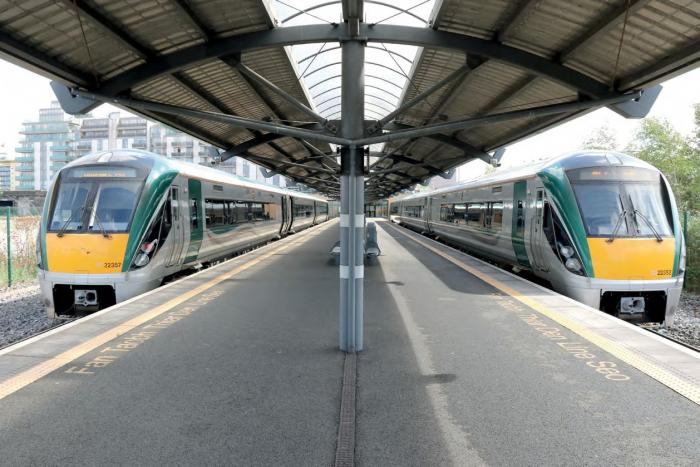
IRELAND
The undamaged or less damaged leading coaches were removed by rail overnight after the incident and heavy rail-borne cranes operated by DB Netze were brought on site to recover the damaged coaches the following day. The line then remained closed for several more days, with DB forecasting at least a week’s closure at the time of writing for repair to infrastructure, especially overhead wires. The adjacent Autobahn closed following the incident and was not reopened to traffic for 24 hours as emergency services were using it for access to the site.
All trains that would normally use the high-speed line were diverted between Frankfurt and Cologne via the classic Rhine Valley route, adding 80 to 90 minutes to journey times.
INVESTIGATORS FOCUS ON EQUIPMENT FAILURE
The local fire brigade responded quickly to the fire, but the train suffered severe fire damage with one aluminium-bodied vehicle largely destroyed and the adjacent vehicles also damaged. The trailer vehicle the fire started in was reportedly not in passenger use due to unspecified technical problems, however the adjacent vehicles on each side were in use. The trailer vehicle which was burnt out was one of two on each eight-car EMU equipped with an oil-filled transformer located under the floor. The transformer is designed to get as hot as 110oC when in use.
Initial reports suggested an axle was on fire when the fire was first detected, and DB has subsequently confirmed the investigating authorities are looking at ‘equipment failure’ as the most probable cause. Equipment from the badly damaged vehicle has been recovered and will be analysed in laboratories to establish the precise cause of the fire.
IRELAND
IARNRÓD ÉIREANN TO PIONEER MTU HYBRID RAIL DRIVES
Iarnrod Eireann (IE) signed a contract with Rolls-Royce engine subsidiary MTU at InnoTrans for the introduction of hybrid diesel-battery traction (an order for similar units by Porterbrook for use in Turbostars was also announced at InnoTrans – see ‘Moving Wheels’).
Six conventional MTU PowerPacks (based on MTU 6H 1800 engines) will be supplied to re-engine two IE 22000 Class ICR DMUs from 2019 onwards for a 12-month trial. These new PowerPacks will be compliant with the future EU Stage V emissions regulations (in force from 1 January 2019) and will be supplied prepared for conversion to a diesel-battery Hybrid PowerPack configuration.
Rolls-Royce will deliver the first three new MTU Hybrid PowerPacks to IE in early 2021 and will simultaneously convert the initial six new conventional PowerPacks into Hybrid PowerPacks so that by the end of 2021 three Class 22000 trains with MTU’s new Hybrid PowerPacks will be in service. An option for three more Hybrid PowerPacks is included in the contract.
If the trials are deemed a success IE plans to carry out a midlife upgrade of its entire Class 22000 fleet using up to 234 MTU Hybrid PowerPacks – the DMUs are presently fitted with MTU PowerPacks using the MTU 6H 1800 R83 engine. MTU says its modelling suggests IE could achieve fuel savings of up to 33% using the new technology whilst reducing noise and NOx emissions. Regenerative braking will provide power for the batteries whilst reducing brake system maintenance costs. IE is also considering battery or Battery EMU hybrid trains for future DART fleet expansion under the National Development Plan.
The MTU Hybrid Power Pack was first trialled under a DB Class 642 DMU in Germany in 2015 comprising a EU Stage IIIB-compliant 315kW MTU 6H 1800 R75 diesel engine, an electric motor and a lithium-ion battery pack capable of producing 400kW. The versions being supplied to IE (and Porterbrook) will use a newer EU Stage V-compliant version of the MTU 6H 1800 engine and a similar MTU EnergyPack battery system. Tim Casterton/Keith Fender
STORM ALI AND A LOO DELAY LUAS!
Storm Ali, the first ‘named’ storm since last winter, caused severe disruption for Dublin’s LUAS tram on 19 September, with the worst problems occurring on the Green line, where trees were blown onto the overhead power supply south of the city centre. The incident was compounded when wires became entangled in a pantograph, resulting in over 200 metres of overhead wires having to be replaced.
A less destructive and unusual delay was caused on the Red line between Busaras and George’s Dock during the storm when a portable toilet being used in connection with building works nearby blew onto the tracks – it was removed fairly swiftly by LUAS staff! Tim Casterton
NETHERLANDS
CROSSING ACCIDENT LEADS TO QUESTIONS ON ROAD ‘VEHICLE’ INTERFERENCE
A level crossing accident on 20 September at Oss, near Nijmegen, resulted in the death of four young children when the electric cargo bike ‘stint’ they were being transported in was struck by an NS-operated Flirt EMU. An adult and another child were badly hurt as well. The accident was reportedly caused by the stint being unable to stop at the level crossing for some reason and as a result it went under the barriers into the path of the train. Both the crossing and train had CCTV, so investigators will be able to ascertain what happened relatively easily, although why it happened may take much longer to fully establish.
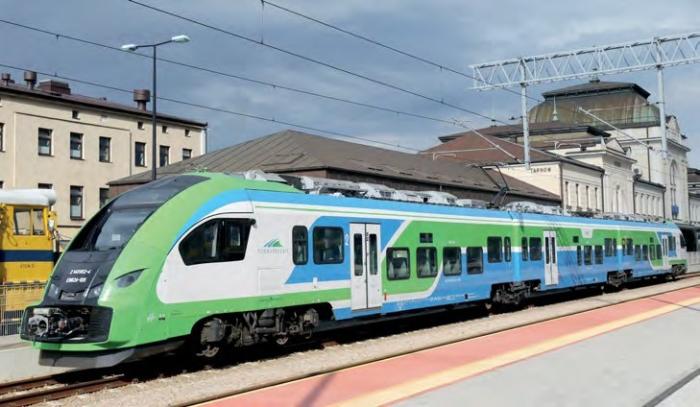
The stint is an electrically-powered two-axle vehicle originally designed to carry goods for delivery companies but very widely used in the Netherlands by schools and kindergartens to transport up to 10 children at a time.
Stints are restricted to 17km/h on public roads; the adult driving stands on a platform at the rear of the vehicle. Around 3,500 were reportedly in use transporting children in the Netherlands at the time of the accident.
The accident led to questions about whether the stint’s braking system was effective and intuitive. However, a more serious potential problem was highlighted – possible electro-magnetic interference between stints and railway signalling, especially that controlling level crossings; several previous instances of stints being unable to brake at level crossings were highlighted by national media – although the exact cause of the incidents remains unclear.
Following initial investigation on 1 October the Dutch government banned all use of stint vehicles on public roads; some child care groups had voluntarily stopped using them in the week beforehand following the accident. The fact the government moved so quickly to ban the widely used vehicles, before the rail accident investigation is complete, suggests one or more serious safety issues had been revealed. Our thanks to reader John Morris for information in this item.
POLAND
ELF II EMUs SLOWLY ENTERING SERVICE
Polish train builder Pesa has been delivering its latest regional EMU, the Elf II, to several Polish operators since late 2017. Whilst around half of the 19 trains for launch customer Koleje Śląskie (KS) in Silesia have been built, many were out of service during the summer period due to faults in the suspension system. As a result, KS had to hire older EMUs from Warsaw regional operator Koleje Mazowieckie and private leasing companies.
Pesa has now delivered the first of the two four-car Elf II EMUs on order for the south eastern Podkarpackie regional government. Podkarpackie ordered seven Elf II EMUs from Pesa in January 2017 (2x4-car and 5x3-car units) for delivery between June 2017 and March 2018, to be operated on its behalf by national regional operator Przewozy Regionalne (PR).
The first Podkarpackie three-car unit entered service six months late in December 2017 due to manufacturing problems; the remaining three-car units were delivered by mid-June. The Podkarpackie regional government has been paid contractual penalties by Pesa for the late delivery. PR is currently operating the new trains largely on the Rzeszow to Tarnow route.
In May Warsaw suburban operator SKM signed a contract worth around PLN310 million (£63 million) with Pesa for 13 Elf II EMUs (5x4-car and 8x5-car sets) for delivery starting in 2019 with an option for a further eight trains (1x4-car and 7x5-car sets) for delivery by 2023.
Pesa also has orders for four more Elf II units for PR funded by the Kujawsko-Pomorskie region for services around Toruń. In addition, the Wielkopolskie regional rail operator Koleje Wielkopolskie, whose services are centred on Poznan, has 10 five-car Elf II trains on order for delivery in 2019.
AIRPORT RAIL LINK FOR KATOWICE
The major Silesian city of Katowice has one of the few airports serving a major city in Poland that has not had a rail link built in the last two decades. This will finally change by 2022 as long developed plans by national infrastructure manager PKP PLK to build a new line on the track bed of the partially disused railway line connecting Tarnowskie Gory and Zawiercie north of the city have received funding. The project will cost €173 million, €117 million of which will come from the EU. Construction is expected to take up to three years, with the new line opening in 2022.
The currently disused line forms one boundary of the airport and lies around 200 metres south of the airport terminal building. Services from Katowice are expected to operate via the length of the line with estimated journey times from Tarnowskie Gory of 17 minutes and from Zawiercie around 23 minutes, meaning journey times to and from the city centre will be around an hour
SWITZERLAND
WORBLA EMU FOR BERN S-BAHN DEBUTS
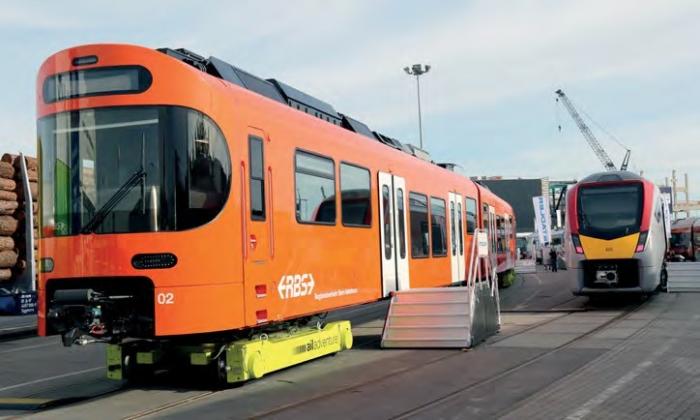
At InnoTrans in September Stadler and Swiss regional operator Regionalverkehr Bern-Solothurn presented the second of 14 unique metre-gauge EMUs built principally to operate S-Bahn services on the S7 route between Bern and Worb. Named the ‘Worbla’ by local people in an online poll, the 100km/h train features eight pairs of doors along its 60-metre length and a fully redundant traction system to ensure very high reliability and availability. Worbla No 02 is seen on Rail Adventure ‘rail buggy’ 1,435mm gauge transporter bogies alongside the Stadler BMU for Greater Anglia. Keith Fender
